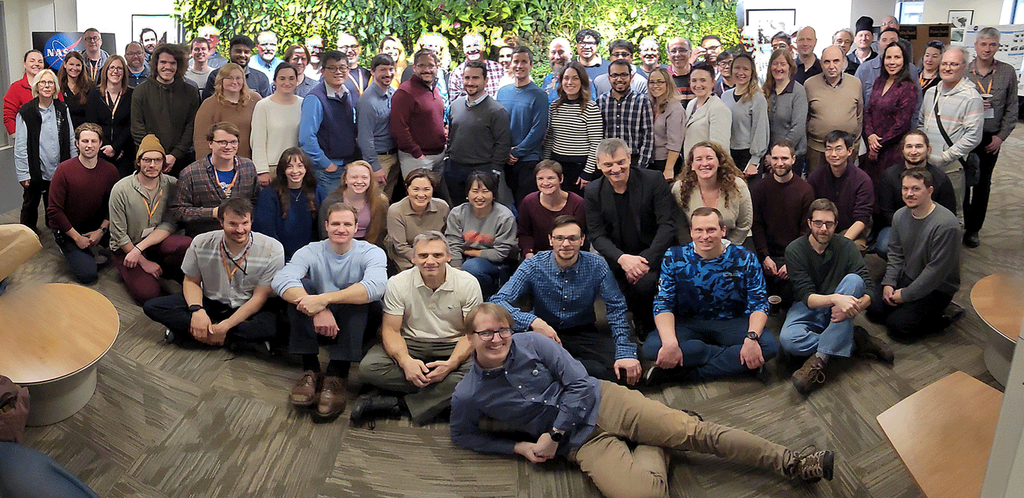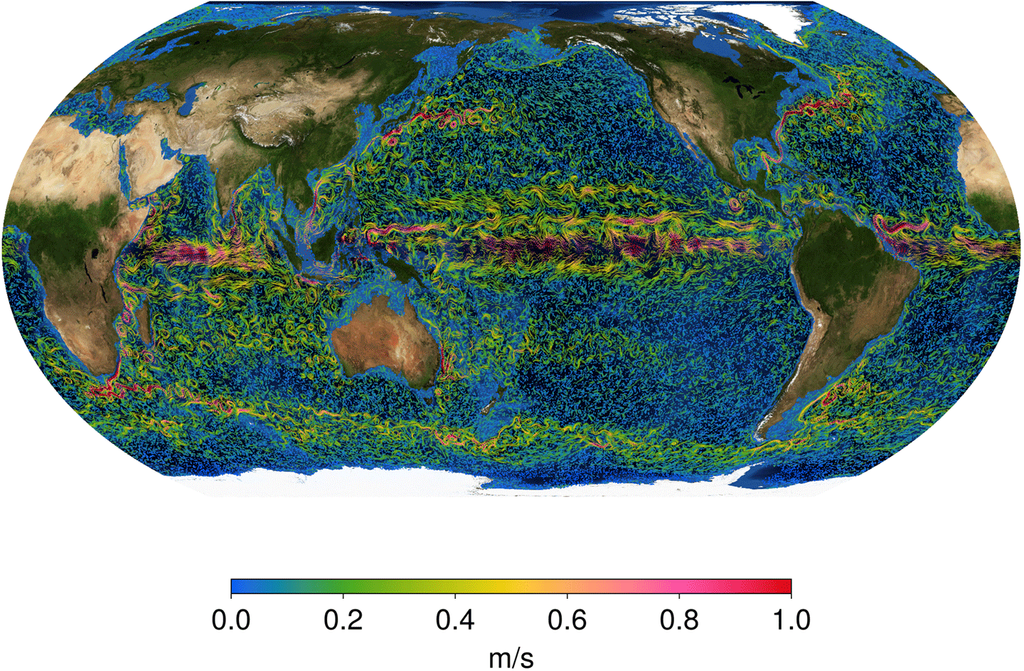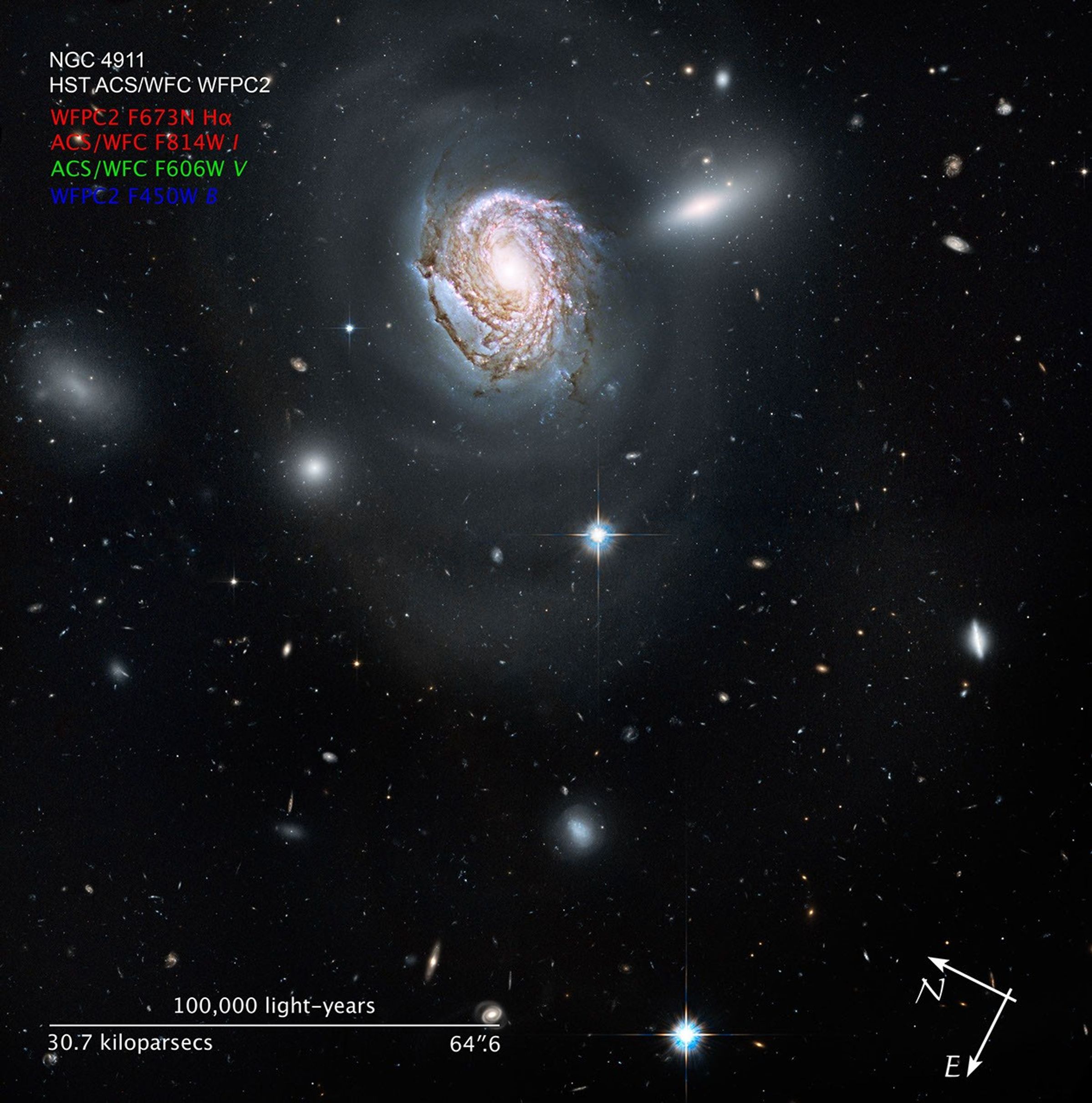1 min read
Spiral Galaxy NGC 4911 in the Coma Cluster

A long-exposure Hubble Space Telescope image shows a majestic face-on spiral galaxy located deep within the Coma Cluster of galaxies, which lies 320 million light-years away in the northern constellation Coma Berenices.
The galaxy, known as NGC 4911, contains rich lanes of dust and gas near its center. These are silhouetted against glowing newborn star clusters and iridescent pink clouds of hydrogen, the existence of which indicates ongoing star formation. Hubble has also captured the outer spiral arms of NGC 4911, along with thousands of other galaxies of varying sizes. The high resolution of Hubble's cameras, paired with considerably long exposures, made it possible to observe these faint details.
NGC 4911 and other spirals near the center of the cluster are being transformed by the gravitational tug of their neighbors. In the case of NGC 4911, wispy arcs of the galaxy's outer spiral arms are being pulled and distorted by forces from a companion galaxy (NGC 4911A), to the upper right. The resultant stripped material will eventually be dispersed throughout the core of the Coma Cluster, where it will fuel the intergalactic populations of stars and star clusters.
The Coma Cluster is home to almost 1,000 galaxies, making it one of the densest collections of galaxies in the nearby universe. It continues to transform galaxies at the present epoch, due to the interactions of close-proximity galaxy systems within the dense cluster. Vigorous star formation is triggered in such collisions.
Galaxies in this cluster are so densely packed that they undergo frequent interactions and collisions. When galaxies of nearly equal masses merge, they form elliptical galaxies. Merging is more likely to occur in the center of the cluster where the density of galaxies is higher, giving rise to more elliptical galaxies.
This natural-color Hubble image, which combines data obtained in 2006, 2007, and 2009 from the Wide Field Planetary Camera 2 and the Advanced Camera for Surveys, required 28 hours of exposure time.
About the Object
- R.A. PositionR.A. PositionRight ascension – analogous to longitude – is one component of an object's position.13h 0m 56.05s
- Dec. PositionDec. PositionDeclination – analogous to latitude – is one component of an object's position.27° 47' 27.12"
- ConstellationConstellationOne of 88 recognized regions of the celestial sphere in which the object appears.Coma Berenices
- DistanceDistanceThe physical distance from Earth to the astronomical object. Distances within our solar system are usually measured in Astronomical Units (AU). Distances between stars are usually measured in light-years. Interstellar distances can also be measured in parsecs.320 million light-years (100 million parsecs)
- DimensionsDimensionsThe physical size of the object or the apparent angle it subtends on the sky.The image is roughly 2.5 arcminutes (230,000 light-years or 72,000 parsecs) wide.
About the Data
- Data DescriptionData DescriptionProposal: A description of the observations, their scientific justification, and the links to the data available in the science archive.
Science Team: The astronomers who planned the observations and analyzed the data. "PI" refers to the Principal Investigator.The image was created from Hubble data from proposals 10842: K. Cook (Lawrence Livermore National Laboratory), M. Gregg (University of California, Davis), L. Macri (National Optical Astronomy Observatories, AURA), J. Mould (University of Melbourne), P. Stetson (Dominion Astrophysical Observatory), and D. Welch (McMaster University); and 11956: K. Noll, Z. Levay, L. Frattare, C. Christian, F. Hamilton, and H. Bond (Hubble Heritage Team/STScI). - InstrumentInstrumentThe science instrument used to produce the data.HST>ACS/WFC and HST>WFPC2
- Exposure DatesExposure DatesThe date(s) that the telescope made its observations and the total exposure time.December 2006 – January 2007 and January 2009 – February 2009, Exposure Time: 28 hours
- FiltersFiltersThe camera filters that were used in the science observations.F450W (B), F606W (V), F673N (redshifted H-alpha), and F814W (I)
- Object NameObject NameA name or catalog number that astronomers use to identify an astronomical object.NGC 4911
- Object DescriptionObject DescriptionThe type of astronomical object.Spiral Galaxy
- Release DateAugust 10, 2010
- Science ReleaseAn “Island Universe” in the Coma Cluster
- CreditNASA, ESA, and the Hubble Heritage Team (STScI/AURA); Acknowledgment: K. Cook (Lawrence Livermore National Laboratory)

The image is a composite of separate exposures made by the ACS and WFPC2 instruments on the Hubble Space Telescope. Four filters were used to sample broad and narrow wavelength ranges. The color results from assigning different hues (colors) to each monochromatic image. In this case, the assigned colors are: F450W (B) F606W (V) F673N (redshifted H-alpha) + F814W (I)

Share
Details
Claire Andreoli
NASA’s Goddard Space Flight Center
Greenbelt, Maryland
claire.andreoli@nasa.gov




































